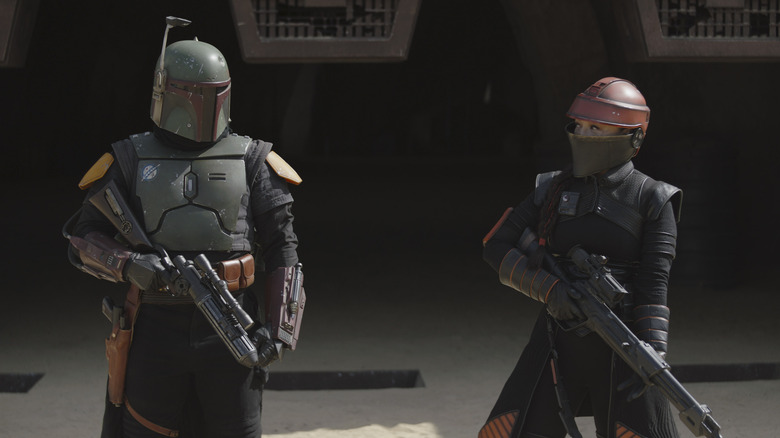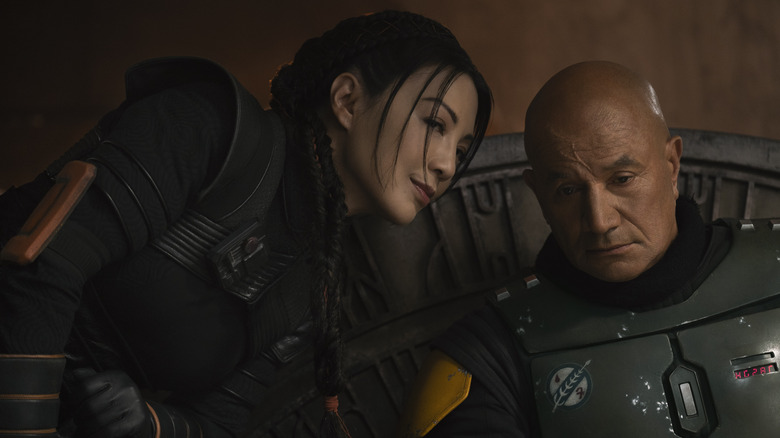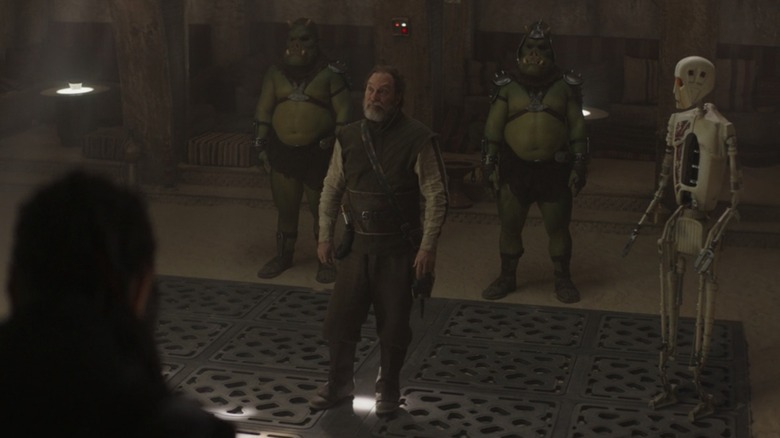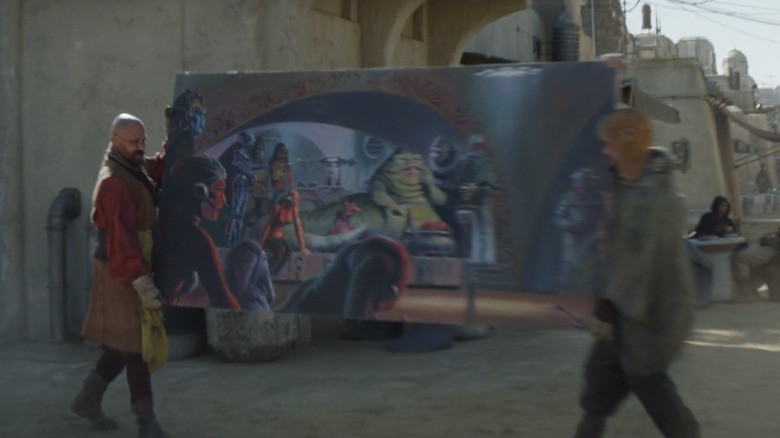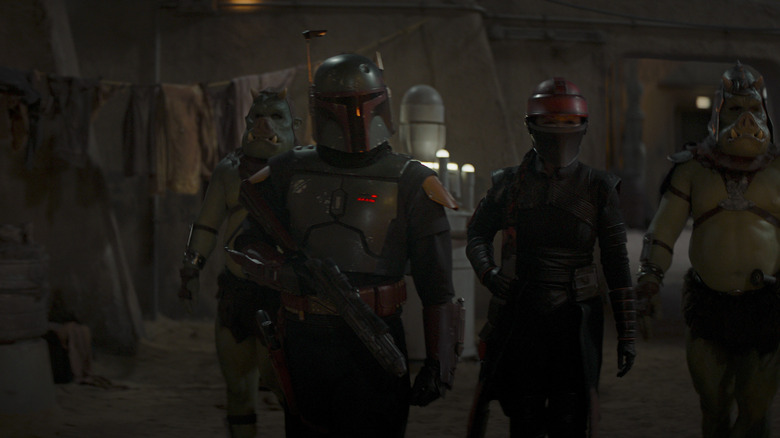The Book Of Boba Fett Navigates The Wild, Crime-Ridden 'Streets Of Mos Espa'
This article contains spoilers for the new episode of "The Book of Boba Fett."
Robert Rodriguez returns to the director's chair for the third episode of "The Book of Boba Fett" dubbed "The Streets of Mos Espa." Where last week's episode kept us rooted mostly in the past, this episode brings us back into the present where Boba Fett (Temuera Morrison) struggles with the respect required to control a place as wild as Mos Espa.
He is beseeched by water merchant Lortha Peel (Stephen Root) to chase out a swoop gang stealing from him, but Fett instead puts these punk cyborgs on the payroll. After they help save his life after a surprise attack by the Wookiee Black Krrsantan (Carey Jones), Fett learns of a plot by the mayor, Mok Shaiz, to essentially turn control of Mos Espa over to the Pyke Syndicate, who arrive by Galactic Starliner to lay claim on their prize.
This is doubly unacceptable to Fett, because we learn that in the previous timeline, the Pyke Syndicate was at least tangentially responsible for the annihilation of the Tusken tribe that took him in.
The Direction and Film References
Robert Rodriguez puts everything on display here in this episode, though there seems to be a layer of artifice to his action scenes that make them feel a little bit distant. Between the fight with Black Krrsantan and the speeder chase, though, there is a lot of action and it really makes up the brunt of the episode.
There is a vein of Toshiro Mifune in the way Temuera Morrison's take on Boba Fett lands in this episode. Like he's a mix between the titular "Yojimbo" (1961) trying to pit other gangs against each other to save the town, and Washizu from "Throne of Blood" (1957), being in over his head and listening to advice that may or may not get him killed. This episode maintains the streak of influence of Western films, too, taking cues from everything from Spaghetti Westerns to classic John Ford fare — especially the elegant sweeping shots of the Dune Sea.
The swoop gang Boba Fett hires feels very much like an '80s remix of the scrumrats from "Solo: A Star Wars Story" (2018). Where Han's fashion in that film felt very much like it was borne of the '70s, these cyberpunks feel like they're from the '80s. Their swoops also feel very much like a mix between Terry the Toad's Vespa and John Milner's coupe in "American Graffiti" (1973).
The rhythm of each episode of "The Book of Boba Fett" feels just a little bit off as a standalone, making me believe the story will play out a lot more smoothly in the binged form. I much prefer week-to-week storytelling, and "The Mandalorian" is able to lean into it easier with its adventure-of-the-week style. "The Book of Boba Fett" eschews that for one big, grand story, but we're still left with the weekly format. It's not a good or a bad thing, but it will be interesting to see how it all plays out by the end.
The Cameos
This episode gives us three major cameos, in addition to those recurring characters we've talked about on previous episodes like 8D8 and the Mayor's majordomo. The first is Stephen Root as Lortha Peel, a simple water seller, who comes to plead with Boba Fett. Swoop gangs are stealing his water and owe him a lot of money and he wants Fett to take care of it. Root is, of course a comedy legend and legendary character actor, appearing in movies ranging from "'O Brother, Where Art Thou" (2000) and "Office Space" (1999) to "On the Basis of Sex" (2018) to "Red State" (2011). He's no stranger to space -based franchises, either: He's appeared as a Klingon in "Star Trek: The Next Generation." Seeing him as the shift water merchant here in "The Book of Boba Fett" was an unexpected delight.
Another big cameo to look for is a vocal cameo. Phil LaMarr provided the voice of the Pyke Boss. LaMarr might be best known for his tenure as Hermes on "Futurama" and as Marvin from "Pulp Fiction" (1993), but he has been a part of "Star Wars" for ages. He regularly provides the animated voices for Bail Organa, Kit Fisto, Orn Free Taa, and a number of other additional voices, starting with the first season of "Star Wars: The Clone Wars."
The last you'll notice is Danny Trejo, a regular collaborator of Robert Rodriguez, joining "Star Wars" as the new rancor keeper. It feels like Trejo has been in just about everything Rodriguez has done, from "Spy Kids" (2001-2011) to "From Dusk Till Dawn" (1996) and all points in between. Though the gift of the rancor from the twins might be on the level, it's difficult to imagine the idea that Fett won't end up fighting this rancor before the series is over.
It might not qualify as a cameo in the traditional sense, but it's worth noting that the actor behind the Wookiee Black Krrsantan is Carey Jones. He played a Predator in the Robert Rodriguez-produced 2010 film "Predators." The 6'7" actor also worked on other Rodriguez projects like "Sin City" (2005) and "Alita: Battle Angel" (2019), making him a natural choice for the comic-based bounty hunter.
What to Look Out For
This episode is chock full of references to every other bit of "Star Wars" you can imagine, from the "Star Wars: Holiday Special" to the comic books.
The episode starts with a shot of a monk of the B'omarr order crawling around outside Jabba's Palace. These first appeared in "Return of the Jedi" (1983) and were based on a concept design by Ralph McQuarrie. These monks achieve enlightenment by having their brains transplanted into the jars in spider bodies. There's also a shot of a Worrt eating some prey outside Jabba's palace. You can see a Worrt in person at Oga's Cantina above the bar.
Another visual reference from past "Star Wars" films comes in the form of the roast Nuna Fett has laid out on his table. Nuna — or swamp turkeys — first appeared in "The Phantom Menace" (1999) both on Naboo and on Tatooine. You can buy Nuna Turkey Jerky at Galaxy's Edge's Ronto Roasters. Rontos are the giant dinosaur-like mounts added to the Special Edition of "A New Hope" (1997) and in this episode Fett demands an entire ronto carcass be sent to feed his new pet rancor.
The scene of dialogue about the rancor is full of many more references as well. Danny Trejo's rancor keeper refers to the Witches of Dathomir riding rancors, which is something straight out of Dave Wolverton's now-Legends book "The Courtship of Princess Leia" (1994). The Witches of Dathomir themselves were brought into the canon in "Star Wars: The Clone Wars" with Asajj Ventress, Mother Talzin, and their entire cadre. Fett also claims to have ridden things 10 times the size of a rancor, which is a reference to his first appearance. In the "Star Wars: Holiday Special" (1978), Fett rides an ichthyodont, a giant dinosaur like creature with bulbous eyes. On the other hand, it could also be a reference to aiwas, the massive creatures that Kaminoans rode over the waves of Kamino, Boba's home planet.
There are a few major Easter eggs to be found in the chase to catch the Mayor's majordomo in Mos Espa. The first is a painting that one of the swoop gang crashes into. This is actually a Ralph McQuarrie concept painting for "Return of the Jedi" (1983). This version has Luke Skywalker edited out of the painting, but was a representation of Jabba's palace for the film when Luke confronts Jabba. Funnily enough, the painting still includes Boba Fett, watching over Jabba's shoulder.
There are two different kinds of notable droids worth pointing out in this scene, too. The first is a Pit Droid from "The Phantom Menace" (1999) who compresses himself to avoid the chase. The second is the Rickshaw Droid from "Attack of the Clones" (2002). In that film, the droid carries Anakin and Padmé to visit Watto, but here it carries two Bith and tries to help them avoid dying in the chase.
The whole chase, including the rickshaw, feels like it was inspired by the opening of "Indiana Jones and the Temple of Doom" and culminates in a crash against a fruit stand. The fruit in question here, though, are meilooruns. Meilooruns were first seen in "Star Wars: Rebels" and were a desired fruit by the rebels. If you look close enough, you can also see meilooruns at Docking Bay 7 at Galaxy's Edge.
The last thing to note would be the Starliner the Pyke's arrive in at the end of the episode. It's not the same design as the Galactic Starliner that you'll be able to visit soon at Disney World, but it is the same idea.
The Verdict
After this episode, I was left wondering what this show means and why we're treated to Boba grasping in his dreams about his identity and all the families he's lost. In his first appearance on the timeline, he loses his father. In "The Clone Wars" all of his mentors abandon him or find themselves in conflict with him. In this show, we see him lose another pair of surrogates he had: Jabba the Hutt and his retinue and the Tuskens that took him in.
The more I watch, the more I feel like Boba Fett's life is the continual trauma of loss and the ceremony of it. He has looked for so long to find a family and a team, people he can trust the way he trusted his father, but they all die. Now he is trying to be that person for others and he might be finding he's not that good at it.
This episode feels like it builds toward that idea, but as we still have more episodes of the season it's entirely possible that this read will mean nothing in the coming weeks.
More than anything, this episode clarified what the ultimate conflict for the soul of Mos Espa will be, between Boba Fett and the Pykes, but it's still unclear what difference would be presented if either side wins. "You're a crime boss," the Joan Jett-looking leader of the swoop gang tells Boba in this episode, "just like the rest of them." And she's right.
"Book of Boba Fett: Chapter 3 – The Streets of Mos Espa" is now playing on Disney+. New episodes of "The Book of Boba Fett" premiere on Wednesdays.
